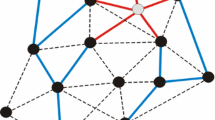Abstract
In order to improve the accuracy and speed of traditional K-Nearest-Neighbor (KNN) algorithms and solve the problem of determining the most appropriate initial center and number of clusters of K-Means algorithm, an improved clustering dynamic threshold location algorithm (ICD-KNN) is proposed in this paper. The algorithm consists of two stages: clustering stage and position estimation stage. The clustering stage employs K-Means clustering algorithm based on Canopy. The Canopy is used as the preprocessing procedure to improve efficiency and clustering accuracy of K-Means algorithm. In the position estimation stage, threshold is set dynamically according to the dispersion of reference points to filter out singular reference points and improve positioning accuracy compared with the previous threshold algorithms. We compare proposed algorithm with several existing algorithms. The simulation results show that the positioning accuracy of ICD-KNN is improved by 10%, 38% and 39% respectively compared with dynamic threshold algorithms (DH-KNN), K-Means algorithms and KNN algorithms.








Similar content being viewed by others
References
Gu, Y., Lo, A., & Niemegeers, I. (2009). A survey of indoor positioning systems for wireless personal networks. IEEE Communications Surveys & Tutorials, 11(1), 13–32.
Xu, H., Ding, Y., Li, P., Wang, R., & Li, Y. (2017). An RFID indoor positioning algorithm based on Bayesian probability and K-nearest neighbor. Sensors, 17(8), 1806–1823.
Pahlavan, K., Li, X., & Makela, J. P. (2012). Indoor geolocation science and technology. IEEE Communications Magazine, 40(2), 112–118.
Lin, K., Wang, W., Bi, Y., Qiu, M., & Hassan, M. M. (2016). Human localization based on inertial sensors and fingerprints in the industrial internet of things. Computer Networks, 101, 113–126.
Li, C., Qiu, Z., & Liu, C. (2017). An improved weighted k-nearest neighbor algorithm for indoor positioning. Wireless Personal Communications, 96(2), 2239–2251.
Ding, X., Wang, B., & Wang, Z. (2018). Dynamic threshold location algorithm based on fingerprinting method. ETRI Journal, 40(4), 531–536.
Zhang, G., Zhang, C., & Zhang, H. (2018). Improved K-means algorithm based on density canopy. Knowledge-Based Systems, 145, 289–297.
Mai, H., & Cheng, L. (2016). The application of clustering algorithm based on improved canopy-Kmeans in operators data. In International conference on engineering technology and application (ICETA), Kyoto, Japan, April, 2016 (pp. 247–252).
Mao, D. (2012). Improved canopy-Kmeans algorithm based on MapReduce. Computer Engineering and Applications, 48(27), 22–26.
He, S., & Chan, S. H. G. (2017). Wi-Fi fingerprint-based indoor positioning: Recent advances and comparisons. IEEE Communications Surveys & Tutorials, 18(1), 466–490.
Long, Z., Men, X., Niu, J., Zhou, X., & Ma, K. (2017). A Wi-Fi indoor positioning modeling based on location fingerprint and cluster analysis (pp. 336–345). Springer.
Altintas, B., & Serif, T. (2011). Improving RSS-based indoor positioning algorithm via K-means clustering. In Wireless conference 2011—Sustainable wireless technologies, Vienna, Austria, April 27–29, 2011 (pp. 1–5).
Cheng, C. Y. (2014). Indoor localization algorithm using clustering on signal and coordination pattern. Annals of Operations Research, 216(1), 83–99.
Li, L., Ma, L., Xu, Y., & Wang, J. (2011). Application of multi-cluster-center based filtering in WLAN indoor positioning. In International ICST conference on communications and networking in China (CHINACOM), Harbin, China, August 17–19, 2011 (pp. 438–441).
Xue, W., Hua, X., Li, Q., Yu, K., & Qiu, W. (2018). Improved neighboring reference points selection method for WiFi-based indoor localization. IEEE Sensors Letters, 2(2), 1–4.
Feng, C., Au, W. S. A., Valaee, S., & Tan, Z. (2012). Received-signal-strength-based indoor positioning using compressive sensing. IEEE Transactions on Mobile Computing, 11(12), 1983–1993.
Liang, D., Zhang, Z., & Peng, M. (2015). Access point reselection and adaptive cluster splitting-based indoor localization in wireless local area networks. IEEE Internet of Things Journal, 2(6), 573–585.
Fang, S. H., Hsu, Y. T., & Kuo, W. H. (2011). Dynamic fingerprinting combination for improved mobile localization. IEEE Transactions on Wireless Communications, 10(12), 4018–4022.
Ge, X., & Qu, Z. (2016). Optimization WIFI indoor positioning KNN algorithm location-based fingerprint. In IEEE international conference on software engineering and service science, Beijing, China, August 26–28, 2016 (pp. 135–137).
Xu, J., Luo, H., Fang, Z., Rui, T., Lin, Y. (2011). Dynamic indoor localization techniques based on Rssi in WLAN environment. In International conference on pervasive computing and applications, Port Elizabeth, South Africa, October 26–28, 2011 (pp. 417–421).
Umair, M. Y., Ramana, K. V., & Yang, D. (2014). An enhanced K-nearest neighbor algorithm for indoor positioning systems in a WLAN. In IEEE computers, communications and IT applications conference, Beijing, China, October 13–15 (pp. 19–23).
Yin, F., Zhao, Y., & Gunnarsson, F. (2015). Proximity report triggering threshold optimization for network-based indoor positioning. In International conference on information fusion, Washington, DC, USA, July 6–9, 2015 (pp. 1061–1069).
Altintas, B., Serif, T. (2011). Improving RSS-based indoor positioning algorithm via K-means clustering. In Wireless conference sustainable wireless technologies, Vienna, Austria (pp. 681–685).
Wang, B., Zhou, S., Liu, W., & Mo, Y. (2015). Indoor localization based on curve fitting and location search using received signal strength. IEEE Transactions on Industrial Electronics, 62(1), 572–582.
Acknowledgements
This work was supported by Science and Technology Major Project of Anhui Province (No. 17030901055) and Development and Reform Commission of Anhui Province, China (2020478).
Author information
Authors and Affiliations
Corresponding author
Additional information
Publisher's Note
Springer Nature remains neutral with regard to jurisdictional claims in published maps and institutional affiliations.
Rights and permissions
About this article
Cite this article
Ding, XX., Liu, YN. & Yang, LY. An Optimized Cluster Structure Routing Method Based on LEACH in Wireless Sensor Networks. Wireless Pers Commun 121, 2719–2733 (2021). https://doi.org/10.1007/s11277-021-08845-x
Accepted:
Published:
Issue Date:
DOI: https://doi.org/10.1007/s11277-021-08845-x




